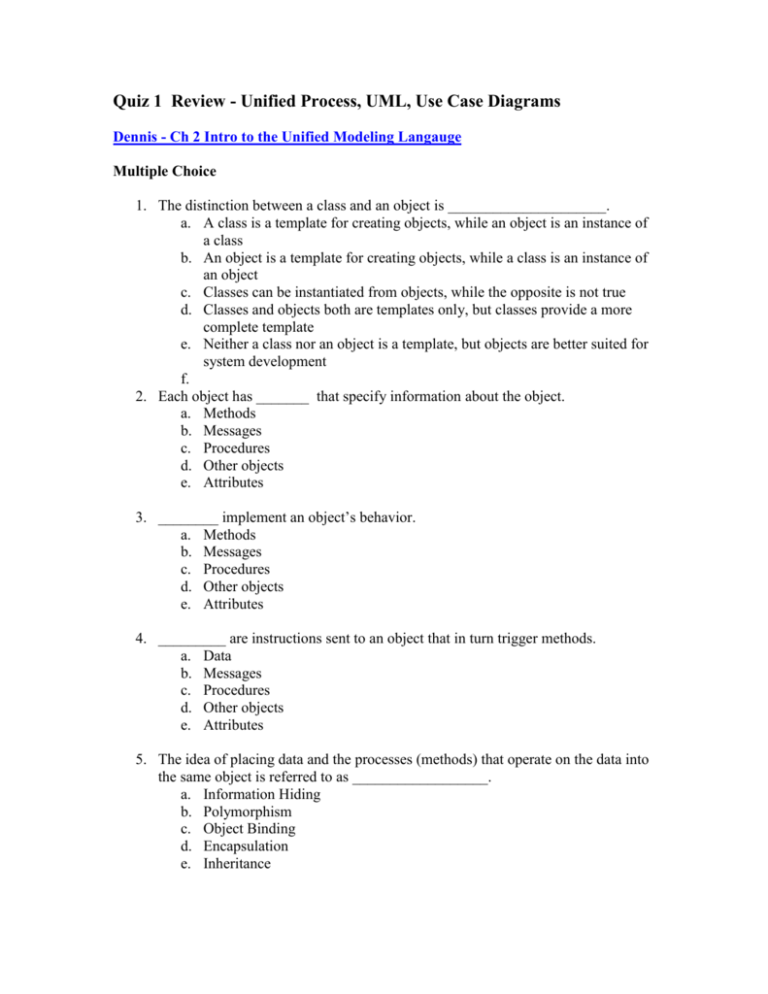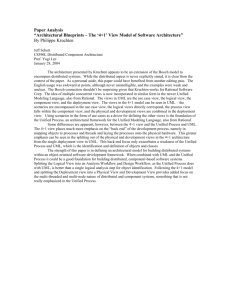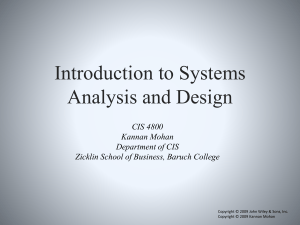UML, Unified Process, Use Case Quiz Review
advertisement

Quiz 1 Review - Unified Process, UML, Use Case Diagrams Dennis - Ch 2 Intro to the Unified Modeling Langauge Multiple Choice 1. The distinction between a class and an object is _____________________. a. A class is a template for creating objects, while an object is an instance of a class b. An object is a template for creating objects, while a class is an instance of an object c. Classes can be instantiated from objects, while the opposite is not true d. Classes and objects both are templates only, but classes provide a more complete template e. Neither a class nor an object is a template, but objects are better suited for system development f. 2. Each object has _______ that specify information about the object. a. Methods b. Messages c. Procedures d. Other objects e. Attributes 3. ________ implement an object’s behavior. a. Methods b. Messages c. Procedures d. Other objects e. Attributes 4. _________ are instructions sent to an object that in turn trigger methods. a. Data b. Messages c. Procedures d. Other objects e. Attributes 5. The idea of placing data and the processes (methods) that operate on the data into the same object is referred to as __________________. a. Information Hiding b. Polymorphism c. Object Binding d. Encapsulation e. Inheritance 6. According to the principle of inheritance, ________________________ a. A superclass inherits methods and attributes from its subclass b. A subclass inherits messages and data from its superclass c. A superclass inherits messages and data from its subclass d. A class can inherit methods and attributes from every other class e. A subclass inherits methods and attributes from its superclass 7. _____ means that the same message can be interpreted differently by different classes of objects. a. Inheritance b. Encapsulation c. Polymorphism d. Information Hiding e. Dynamic Binding 8. In dynamic binding, the specific method that is used by the program must be determined at ____________ a. Compile time b. Run time c. The time of development d. The time of specification of the system e. None of the above 9. A ___________ models the interaction of the information system with its endusers and other external systems. a. Implementation plan. b. Use case diagram. c. Class diagram. d. Package diagram. e. Database diagram. 10. _________ diagrams represent the things, concepts or ideas that are contained in an application. a. Interaction diagrams b. Deployment diagrams c. Sequence diagrams d. Class diagrams e. Activity diagrams True/False 1. A class is a general template used to define and create specific instances known as objects. 2. Attributes implement the behavior of the object while methods model the information contained within the object. 3. A concrete class is a class from which instances (or objects) can be created. 4. An abstract class is primarily used as a template for defining other classes, and no instances can be created from abstract classes. 5. The same message can be interpreted differently by different objects is often referred to as inheritance. 10. The objective of UML is to provide diagramming techniques in the analysis and design phases that easily translate to Java code during the implementation phase. 11. UML provides a common vocabulary of object-oriented terms and diagramming techniques which help model information system projects from analysis through implementation. 12. UML provides diagramming techniques to present the dynamic behavior of the system, while it makes no attempt to model the structure of the information system. 13. UML structure diagrams provide a way to model the data and the static relationships of an information system. 14. Class diagrams model things, ideas/concepts contained in an application, and do not depict the relationship among classes. 15. Object diagrams are helpful for an analyst to uncover additional details of a class, including additional attributes, methods and relationships to other objects. 16. Primary purpose of a use case diagram is to understand and document the requirements of an evolving information system. 17. In UML model diagrams, only classes are allowed to have stereotypes, since there is no need for stereotypes for other UML elements such as use cases and relationships. 18. The requirements workflow is started and completed in the inception phase of the Unified Process. 19. The analysis workflow is predominantly associated with the elaboration phase of the Unified Process. Project management workflow is the only workflow that truly spans across all phases of the Unified Process. Support - Introduction to the Unified Process 1. The process model or methodology we are teaching in this class is called____. a. Unified Process b. Waterfall c. Rational Unified Process d. Agile Delopment Process e. Extreme Programming 2. Which one of the following is NOT a characteristics of UML a. Is graphical b. Allow software engineers to communicate quickly and accurately c. Is a modeling technique d. Was established by the Object Management Group e. Is used to represent deliverables of the structured development paradigm 3. UML stands for a. Universal Metadata Language b. Universal Modeling Language c. Unified Micro Language d. Unified Modeling Language 4. Which of the following is most true about UML. a. UML uses Use Cases sometimes but not always b. UML is use case centric c. Use cases are only used if there is a misunderstanding in requirements d. Use cases are only used as support to the data dictionary. 5. Which of the following are the workflows of the unified process a. Initiation, Elaboration, Analysis, Design, Implementation, Testing b. Requirements, Analysis, Design, Implementation c. Inception, Analysis, Implementation d. Requirements, Analysis, Construction, Implementation 6. Which of the following are the phases of the unified process a. Inception, Analysis, Construction, Implementation b. Initiation, Elaboration, Construction, Implementation c. Inception, Elaboration, Construction, Transition d. Initiation, Analysis Construction, Transition 7. Initial business model, project plan, and initial vision are deliverables of what PHASE of the unified process: a. Planning b. Inception c. Initiation d. Elaboration e. f. g. h. i. j. Requirements Analysis Design Construction Implementation Transition 8. The completed domain model (use cases, classes), completed business model, and project plan are deliverables of what PHASE of the unified process: a. Planning b. Inception c. Initiation d. Elaboration e. Requirements f. Analysis g. Design h. Construction i. Implementation j. Transition 9. Working software, user manuals, and acceptance testing documentation are deliverables of what PHASE of the unified process: a. Planning b. Inception c. Initiation d. Elaboration e. Requirements f. Analysis g. Design h. Construction i. Implementation j. Transition 10. Scope Definition, stakeholder identification, risk analysis, and team building are done during what unified process workflow. a. Planning b. Inception c. Initiation d. Elaboration e. Requirements f. Analysis g. Design h. Construction i. Implementation j. Transition 11. Listing candidate requirements , domain modeling, defining functional requirements, and use case modeling are done in which unified process workflow. a. Planning b. Inception c. Initiation d. Elaboration e. Requirements f. Analysis g. Design h. Construction i. Implementation j. Transition 12. Creating Packages, creating design classes, defining method signatures, creation of interaction diagrams are all done in what unified process workflow. a. Planning b. Inception c. Initiation d. Elaboration e. Requirements f. Analysis g. Design h. Construction i. Implementation j. Transition Deliverables - Use Case Diagrams 1. A use case diagram is all of the following EXCEPT: a. A formal way of representing how a business system interacts with its environment b. Definition of the workflows of the unified process c. Illustration of the activities that are performed by the users of the system d. A scenario-based technique in the UML e. A sequence of actions a system performs that yields a valuable result for a particular actor. 2. The three types of relationships use cases have in a use case diagram include: a. Extension, representation, elaboration b. Extension, inclusion, and generalization c. Inclusion, representation, realization d. Elaboration, generalization, boundarization 3. Stakeholders are customer, product managers, and perhaps others. a. True b. False 4. Software Architects establish and maintain architectural visions a. True b. False 5. An actor is a user or outside system that interacts with a system being designed in order to obtain some value from the interaction a. True b. False 6. The include relationship in use cases is the ability to add optional functionality in a use case a. True b. False 7. The extend relationship in use cases is the ability to have one use case withint another. a. True b. False True or False 1. True or False Inheritance is a form of reuse that allows attributes and methods to automatically flow o the subclass a. True b. False 2. True or False Polymorphism allows the same message to be interpreted differently by different objects. a. True b. False 3. True or False Dynamic binding (late binding) is a technique that delays object typing until run-time. a. True b. False 4. The primary purpose of a class diagram is a. to construct a vocabulary that is understood by both the users and analysts. b. to show the users interaction with the system c. to uncover additional details such as attributes and methods of a class d. model the interaction between the system and its environment 5. The primary purpose of a object diagram is a. to construct a vocabulary that is understood by both the users and analysts. b. to show the users interaction with the system c. to uncover additional details such as attributes and methods of a class d. model the interaction between the system and its environment 6. The primary purpose of a use case diagram is a. to construct a vocabulary that is understood by both the users and analysts. b. to show the users interaction with the system c. to uncover additional details such as attributes and methods of a class d. model the interaction between the system and its environment 8. Which of the following Is NOT in the Inception phase of the Unified Process a. Create a business case for the proposed system b. Do a feasibility analysis for the proposed system c. Perform business modeling d. Define the necessary database tables 9. Which of the following is NOT in the Elaboration phase of the Unified process. a. Completion of the business plan b. Completion of the risk assessment c. Forming the project plan d. Building structural and behavioral models e. Creating a Vision for the proposed system 10. Which of the following is NOT the purpose of the Analysis workflow of the Unified process. a. Make sure both developers and users understand the underlying problem b. Identify seful reusable classes for class libraries c. Depict classes and their interactions d. Create a vision for the proposed system









